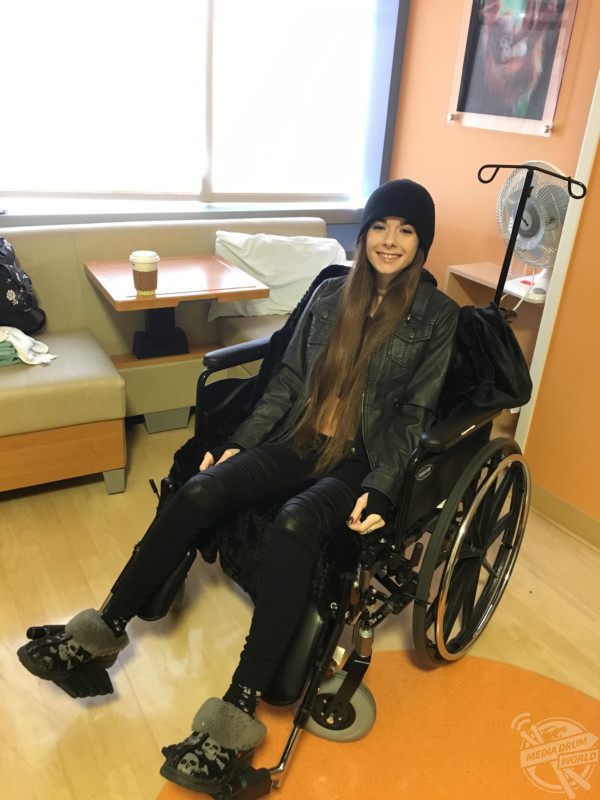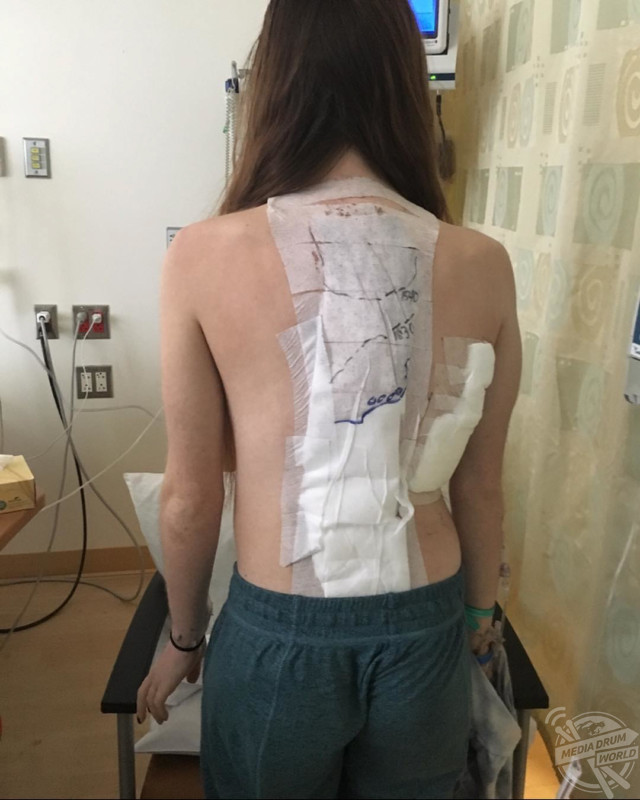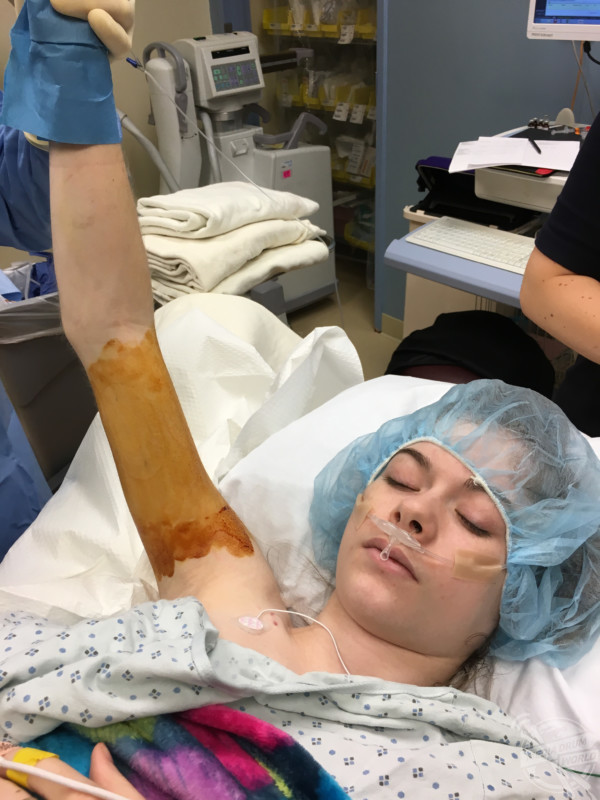By Alyce Collins
AFTER being diagnosed with scoliosis, this woman had a spinal fusion to correct her curved spine, but an INFECTION ate away at the metal rods and eighteen months after surgery she SNEEZED and the metal rods in her spine SNAPPED – leaving her THROWING UP BLOOD.
Librarian and student Rosie Paltridge (19) from California, USA, first noticed a dull back pain when she was six years old, progressing constantly and at the age of 12, doctors noted three curves in her spine, at the cervical, thoracic and lumbar regions and Rosie was given a back brace to wear.
However, the back brace did little to delay the curve from progressing and by 15 Rosie was diagnosed with a 17-degree cervical curve, 63-degree thoracic curve and 42-degree lumbar curve. On June 4, 2015, Rosie had a spinal fusion whereby rods were inserted into her spine.

Three months later, Rosie was finally able to sit up unassisted and walk around independently. She felt amazed at her recovery, until approximately six months after surgery when the pain returned, and her energy levels dropped. This decline persisted for months until she was admitted to hospital after collapsing, exactly a year after the original surgery.
In June 2016, Rosie was diagnosed with a staph infection which is believed to have originated from the metal hardware. She was discharged after a few weeks but didn’t recover, until in August it became apparent she was wrongly discharged and she returned to the hospital at a critical point. Doctors warned that if she hadn’t been admitted that day, she would have died because there was an unknown abscess near Rosie’s spine which had burst.
Due to the length of time that the infection remained in Rosie’s body, it began to eat away at the metal and destabilised its structure. By September, the top of the rod was protruding noticeably and had to be partially removed, leading the two rods in her back uneven.
Rosie started feeling stronger as her body was finally rid of the infection it spent over a year fighting, but by March 2017, Rosie sneezed while at home and heard a horrifying crack, which was the remaining full rod in her back snapping.

“I had unexplained back pain at the age of six, which we assumed was from my many hours I was training as a gymnast,” said Rosie.
“When I turned 12, doctors said I needed a brace as my curves were around 10, 35, and 20, going from cervical down to lumbar. I was supposed to wear the brace as close to 24 hours a day as I could, I would even sleep in it occasionally.
“However, even with the brace, my curve continued to grow and by the time I was 14, my thoracic curve had jumped to the high forties. I had my spinal fusion in June 2015, and I woke up two inches taller.
“After three months I started to improve, and I could finally sit up on my own and move around the house. For a month, I got a taste of how a successful correction could be and I felt that things were looking up.
“Sadly, I had no idea what was happening when my pain became to increase by December, and by June 2016 I collapsed. I didn’t know what was going on, my blood hurt, every breath caused actual physical pain to the entirety of my body – that was the staph infection. They said if I hadn’t arrived when I did, I would have died within 24 hours.

“We assume the infection originated from the hardware, so my body began to reject the hardware instead of fuse with it. I also had an abscess forming which we were unaware of at the time because it was tucked up under my titanium next to my spine in the thoracic region, so it was blocked by the hardware in scans.”
Rosie was taken into hospital and kept as an inpatient for a month before being discharged in July. However, when she returned to hospital in August, doctors then found that her body was still fighting the staph infection as well as a burst abscess.
The infection diminished the strength of the metal rods in her spine, causing one to reject and contributed to the other rod snapping. Rosie blogs about her journey on Instagram as a way to spread awareness for scoliosis, which she admits is misunderstood and underestimated.
“The infection prevented my body from accepting the metal and severe infections like that eat away at bone and metal, destabilising the structure. My body may have known the rod was the source of infection and was trying to rid myself of it,” said Rosie.
“In October the top right part of my rod was clearly protruding out of my back. Doctors cut the right rod halfway down and although I was horrified that they were leaving my rods asymmetrical, I understand the logic behind opening me up as minimally as possible. I could have easily died by being put under anaesthesia from ow weak I was.
“After the operation, I felt much improved after due to how deformed I was from the rod rejecting. I felt so free with it out of my body. Previously, I could barely lay on a bed because of how far the screws poked out.

“I started getting back into the swing of life and putting all that behind me, until six months later when I sneezed in my room and heard a crack and felt the most outrageous pain. Then suddenly I had movement in my torso, which is inconsistent with a titanium fusion.
“I knew what happened but couldn’t believe it. I had X-rays taken at the hospital and they confirmed that I had broken my rod. We assumed that the infection ate away at the hardware. It takes two years for bone to accept titanium and fuse together, but I didn’t have this time under my belt before the infections began, so my fusion was unstable.
“Unfortunately, doctors refused to operate because it was a clean break and another operation could be dangerous, so they hoped my back would remain stable. However, by November I started to black out, forget words and throw up blood because the rod was stabbing a nerve in the spinal cord which is used for brain function. So, in November 2017 I had to have an experimental operation to remove the broken rod.
“They put tubes in through the right side of my ribs and deflated my lung in order to get to the hardware and remove it. They then lay me on my stomach and removed the remaining rods.
“They removed two sections from my ribs on the right side and used that, and a protein serum, to bind it to what was left of my spine and avoid more unnatural materials in my body to decrease chances of another rejection. They also added two cross links which are horizontal bars that go across the top and bottom of the fusion, providing more stability.

“After this last operation, I still struggle daily but I’m accomplishing more than anyone thought possible. It’s hard to find meaning in life when your ambitions surpass your body’s capabilities, but you learn to find a new purpose. For me, that’s educating as many people as possible on the seriousness of this condition.
“Scoliosis is far from being understood from a medical perspective, and those who are affected by this condition are presented with no education, few treatment plans and no emotional support.
“I want to empower the community to explore every available option, and to be fully informed on how this will impact their life. Trust your gut, believe in your body, fight for answers, for your health. Never let the world tell you that you can’t, but more importantly never tell yourself you can’t, as you’re the only one who can truly stand in your way.
“You are worthy of love and any extra effort that needs to be expressed by other people due to your limitations.”
To see more, visit www.instagram.com/bent.not.broken7






